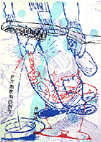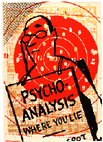|
I Lost my Ass In his most recent show at Kunst Gallery in Sydney, Jeff Gibson produced work that continues his engagement with ideas on contemporary constructions of masculinity. Through a series of 10, 3-colored screen prints, 3 short video pieces and another 3 larger format, multi-colored screen prints, he envelops the viewer in a rakish sensibility, ironically one which confronts the blunders of contemporary masculine vanity in an age where the rug has been firmly pulled from underneath the man before the mirror. |
|
Jeff Gibson, Hygiene |
Despite the obvious historical disparities with a
comparison between Gibson’s work and William
Hogarth’s The Rakes Progress, they both share
ideas about popular culture, marketability and both use
didactic strategies; albeit Hogarth’s intention was
to instruct while Gibson’s is to confound. What I
want to pursue here are certain comparisons between
Hogarth and Gibson, as a means of reflecting on the
general history of print media and defining critical
strategies for print technologies in a contemporary
context. Issuing from the fervour of the Enlightenment, Hogarth’s The Rakes Progress, illustrates a moral narrative concerning the rewards of virtue and the wages of sin, resulting in his engraved plates being worn thin by the popular demand for these informative moral lessons. The tragi-comedy of the rake’s tale is invoked in a typically theatrical manner. The stage is set and the mise en scene filled with pictographic signs to be read by the viewer as a highly moral tale. This allegorical impulse draws on a rich history of picture story telling which carries on through Hogarth’s time and beyond it; in the lessons of the "penny dreadful" and in a more contemporary context, the comicstrip. Gibson’s work continues the tradition of The Rake’s Progress, particularly in the way his work functions as allegory. As Craig Owens has defined it, contemporary allegory is an attitude as well as a technique, a perception as much as a procedure and occurs whenever one text/image is doubled by another. Allegory, like the rake himself, has also suffered an enforced form of decrepitude through Modernism’s intolerant attitude towards it. |
|
Jeff Gibson, untitled, 1995 |
It is in Gibson’s self-consious use of screen
print as a reproductive media and the use of
superimposure or the layering of images lifted from
popular culture (and effectively styled and aesthetically
elevated in order to inhabit the white cube) that
Gibson’s work is antagonistic to canonical
Modernism. Here, similarities to Hogarth and the popular
theatrical signs he used to create narrative, can be
paralleled to Gibson’s use of sampling, inviting the
musical analogy of "hip-hop". But where Gibson differs from Hogarth and indeed where contemporary allegory differs from its traditional usages is in its lack of sermonising. Gibson’s anti-hero is decentred, fractured, abstracted and formalised. Any notion of linear moral narrative is confounded by the conflation of details accumulating both within and across the works. If a story is unfolding then quite a different structural zone is being navigated. Its one which actively mocks the Enlightenment and its privileging of morality. Yet if any form of moralising occurs in Gibson’s work it is of a nature that works its influence through the use of humour. The works exude a certain elegance of wit. Our decentred but aesthetically seductive anti-hero navigates popular manifestations of masculinity, in particular caricatures of comedic testosterone infected mishaps. This is a mediated subject where psychology has replaced morality and the suave theatricality of the white cube can be read, as figuratively as the popular theatre in Hogarth’s work, as the analysts consulting room. In Gibson’s work, subjectivity is displaced from the personal to the public realm. The lifted images, like carefully scattered Freudian detritus blown off the street, becomes his tongue-in-cheek repertoire. The rake, these days is at the comic end of the tragic-comic scale. He is someone like Seinfeld, who psychologises all his rakish activities. Gibson seems to do the same. Here we have a rakish sensibility that perhaps, takes up where Hogarth leaves off and through its smoothly mannered aesthetic, shifts that Bedlam of Hogarth’s rake into the realm of the Seinfeldian comic. Gibson may have lost his ass, but unlike Hogarth’s rake, it hasn't wiped the smile off his face. Neil Emmerson |

